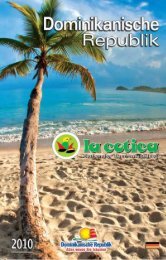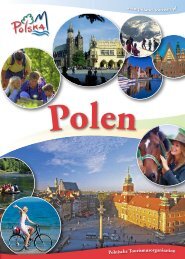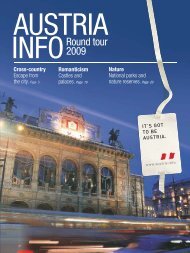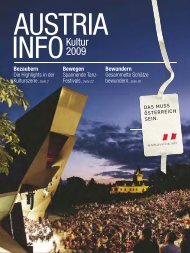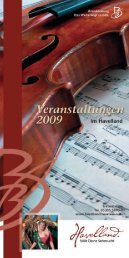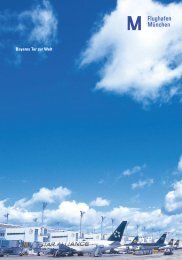i Dominican Republic - travelfilm.de
i Dominican Republic - travelfilm.de
i Dominican Republic - travelfilm.de
You also want an ePaper? Increase the reach of your titles
YUMPU automatically turns print PDFs into web optimized ePapers that Google loves.
the other hand, conditions are favorable<br />
for a large-scale fishing industry.<br />
The soil of the area belongs to the<br />
cretaceous period and most of the<br />
peninsula is layered with white, pink,<br />
green and gray marble, quarried to<br />
supply the industries that process it in<br />
Santo Domingo. In addition, coconut, fish<br />
and shellfish abound.<br />
During the pre-Hispanic period, the<br />
territory belonged to the chieftainship of<br />
Maguá un<strong>de</strong>r the domain of the Ciguayo,<br />
Guarionex. From excavations carried<br />
out, interesting archeological pieces have<br />
been preserved as pointers to the history<br />
of that period.<br />
Christopher Columbus arrived in Samana<br />
on January 12, 1493. The following day<br />
the first battle in the New World took<br />
place between the Taínos of Ciguayo and<br />
the Spaniards. According to a journal<br />
entry in the admiral’s own handwriting,<br />
“[he had] never seen so many arrows fly<br />
over a ship.” Before leaving for Castilla<br />
on January 16th of the same year, he<br />
dubbed the bay the Golfo <strong>de</strong> las flechas<br />
(Gulf of arrows).<br />
104<br />
Santa Bárbara <strong>de</strong> Samaná was foun<strong>de</strong>d<br />
in 1756 by the Spanish brigadier and<br />
the governor of the island, Francisco<br />
Rubio Peñaranda.<br />
Samaná celebrates its patronal feast<br />
on December 4th. For more than half a<br />
century Doña Vetilia Peña has initiated<br />
the festivities in her home, with the<br />
bambulá, a ritualdance that can only<br />
be seen and danced in the Samaná<br />
peninsula during its patronal festivities<br />
and on October 24th, the feast day of<br />
San Rafael.<br />
The Chivo Florete, a dance of suggestive,<br />
erotic movements that are consi<strong>de</strong>red<br />
inappropriate by some, is a dance<br />
typical of Samaná, as well as the olíolí,<br />
it forms a part of the carnival’s<br />
comparsas (costumed groups dressed<br />
alike at carnival time) in which only men<br />
participate.<br />
In the city you will find different business<br />
centers and hotels <strong>de</strong>signed for tourists<br />
which offer comfortable accomodation.<br />
See Hotel Directory, page 70.<br />
For those hungry for an exotic treat,<br />
Samaná is famous for its fabulous typical



